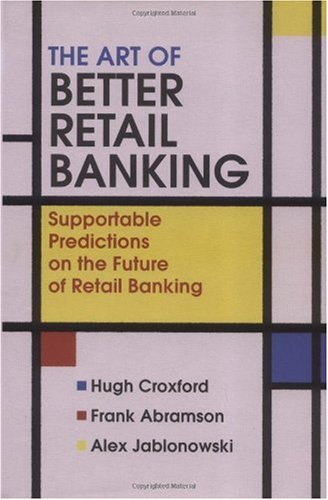(Ebook) The Art of Better Retail Banking: Supportable Predictions on the Future of Retail Banking by Hugh Croxford, Frank Abramson, Alex Jablonowski ISBN 9780470013205, 9780470014813, 0470013206, 0470014814
Our objective with this book is to discuss retail banking with a view toidentifying changes that will materially improve the value proposition forretail banking customers, and benefit the bank and its owners – all three atthe same time. This book seeks to explain the situation and the opportunities. It usesfacts, experience and logic to argue the positions. Only a basic familiaritywith banking isassumed.The most important aspects of retail banking areaddressed in some depth. We’ve tried to keep the book short and readable, andgone into some detail to explain the science, the engineering and the pivotalchange force, which we believe to be the art of banking. The art is largelymissing today. Necessarily there are some ‘soft’ concepts that we cannot ‘prove’,but we have incorporated these and done our best to discuss them, because somewill prove to be powerful influences, and a few will be very powerful. Let’s face it; this book has to be as much about customer behaviour asanything else, and their behaviour will be the single most powerful force. Muchof the rest is about organisational behaviour, and this will determine theeffectiveness of both the banks’ responses to consumer needs and theirinitiatives to meet opportunities.This book has been written with several audiences inmind – an interesting challenge in itself: Bank staff , Senior managers of financial institutions,those interested in the banking industry, Investors, Customers, Students, Regulators,politicians and government officials. There are two parts to this book. The first part –Chapters one to five – seeks to establish an awareness and understanding ofwhat retail banking is about. Those really familiar with retail banking shouldstill browse through these chapters; they are not meant to be a boring primer,even though the first two or three chapters get dangerously close. The intentis to establish a common understanding, so that in the second part, we can raiseand widen the overall level and scope of the debate. Nobody gets left behind. Whoeveryou are, there is stuff in the first part that you didn’t know!Following the introductory chapter, the second chapterlooks at the basic model, and is largely concerned with the results of thescience involved with banking. It is a simple and limited view, but no lessaccurate for that, and covers the fundamental raison d’ˆetre of retail banking.The third chapter, on account types and deliverychannels, is centred on the engineering that transforms the science into theproducts and services that the customers see. It gives an appreciation of therange of activities in a retail bank.The fourth chapter discusses the challenges, usingbank figures from the banks’ annual reports, to size and scope the realitiesand opportunities.The fifth chapter revolves around informationtechnology (IT). In our opinion, the area of IT and its predecessor, dataprocessing, have made enormous contributions to retail banking, but have nowbecome the largest obstacles to better banking. The thorough integration of ITinto the retail banking business is poised to be the catalyst that will enablebetter banking to emerge.In the second part – Chapters six to ten – we leavebanking certainties behind. We spin our wheels, and take some risks andliberties. Like each of us authors, no reader will agree with it all.Chapter six concentrates on the real world ofbusiness. It relies heavily on observation of non-bank businesses, on a fewhome truths and cold facts. There is no reason for retail banking to behavedifferently to other businesses.We relate the retail banking planet to the realworld that we live in.We think it all through a little, starting with thecustomers themselves.Chapter seven introduces propositions on how best toproceed, given these challenges. Undoubtedly, there are other approaches outthere.In Chapter eight we look at how we should prepare forthe future. Clearly, established banks cannot change overnight. There has to bean elaborate preparation period, which has already started in most banks,irrespective of their various directions. New banks don’t have it easyeither.We look at the most difficult of changes, those required in the mindsetsof people wedded to the status quo – bankers, customers and investors, no less!The introduction of better banking will be a step change challenge, leading tosignificant performance improvement over some years. Such a change has deep implicationsfor all members of the bank, customers and many others. Using some form ofR&D leads to a business plan, a business model and a transition strategy.In Chapter nine we make predictions for the directionof retail banking. We are well aware that there are multiple approaches that willmake sense generally, and that some will make more sense than others for aparticular bank. Our objective was to get to this point, and we can onlyapologise that the line to it was not as straight as we initially wanted it tobe. This is biggish wave stuff, and each bank has every reason to handle thesepredictions with the utmost caution. Our predictions come in only two flavours –simple predictions and braver predictions from over the horizon. These predictionsare based on facts and realities, not flights of fancy.All the illustrative and arithmetic examples usesimple interest and constant currency values for clarity.Our conclusions end the book.
*Free conversion of into popular formats such as PDF, DOCX, DOC, AZW, EPUB, and MOBI after payment.


